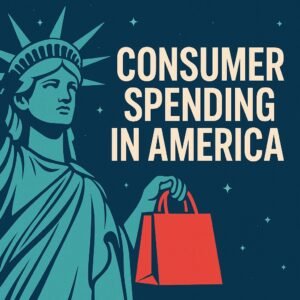Every year, Americans spend trillions of dollars fueling the world’s largest economy. During holiday weekends like the Fourth of July, that consumer firepower reaches extraordinary heights. With just 4% of the global population, the U.S. accounts for nearly 25% of global consumer spending.
American consumer spending drives not only the domestic economy but influences markets worldwide. During Independence Day celebrations, this spending power becomes particularly visible as families across the nation open their wallets for food, fireworks, and festivities.
In this article, we’ll explore why American consumer spending dominates globally, examine where billions of dollars go during July 4th celebrations, and uncover what this reveals about the U.S. economy’s unique structure.
The U.S. Is the World’s Spending Superpower
To understand why the Fourth of July generates such massive spending, you must first grasp how the U.S. economy operates. The numbers tell a compelling story about American consumer behavior.
The Scale of American Consumer Spending
As of 2025, the statistics are striking. The U.S. makes up only 4% of the world’s population, yet it accounts for 23% of all household spending worldwide. This disproportionate share reflects the enormous purchasing power of American consumers.
Consumer spending represents nearly 70% of U.S. GDP. This percentage far exceeds other major economies and highlights America’s consumption-driven economic model.
International Comparisons
Other developed nations rely less heavily on consumer spending for economic growth:
- Germany: Consumer spending accounts for approximately 52% of GDP
- Japan: Consumer spending represents about 55% of GDP
- China: Consumer spending contributes roughly 38% to GDP
These comparisons reveal that the United States has built a uniquely consumption-driven economy. For Americans, buying goods and services isn’t just economic behavior—it’s woven into the cultural fabric.

Where the Money Goes on July 4th
The consumption-driven mindset of American consumers reaches peak intensity during patriotic holidays. The Fourth of July exemplifies this phenomenon perfectly.
Total Independence Day Spending
Each year, Americans spend over $13 billion celebrating Independence Day. This massive expenditure occurs within just a few days, demonstrating the concentrated power of American consumer spending during holiday periods.
Breaking Down the $13 Billion
The spending distribution reveals interesting patterns about American priorities and preferences:
Food & Beverages: $9.5 billion (73%) Food and drink dominate July 4th spending. Cookouts, barbecues, and beer purchases drive this category. July 4th consistently ranks as the biggest beer-selling holiday in the United States. Grocery stores and restaurants see massive spikes in sales during the holiday weekend.
Fireworks: $2.3 billion (18%) The fireworks industry experiences its biggest sales period during July 4th. This $2.3 billion represents nearly the entire annual consumer fireworks market. Interestingly, most fireworks sold in America are imported from China, making this a prime example of how American consumer spending influences global trade.
Retail/Apparel: $0.6 billion (5%) Patriotic clothing, decorations, and accessories contribute significantly to July 4th spending. Red, white, and blue merchandise flies off store shelves during the weeks leading up to Independence Day.
Travel & Gasoline: $0.4 billion (3%) Americans travel extensively during the July 4th weekend. Gas stations, airlines, and hotels benefit from increased consumer spending as families plan holiday getaways.
Events & Entertainment: $0.2 billion (1%) Concert tickets, festival admissions, and other entertainment purchases round out the spending categories.
Why Americans Spend So Much
Understanding the drivers behind American consumer spending requires examining several interconnected factors. These elements combine to create a perfect storm of consumption that sets the U.S. apart from other nations.
High Disposable Incomes
American households enjoy some of the highest disposable incomes globally. This wealth provides the foundation for extensive consumer spending. When people have money to spend beyond basic necessities, they tend to spend it.
The median household income in the United States significantly exceeds that of most other developed nations. This income advantage translates directly into higher consumer spending patterns.

Easy Access to Credit
The American financial system makes borrowing remarkably accessible. Credit cards, buy-now-pay-later applications, and promotional financing options encourage immediate purchases. This credit availability allows consumers to spend beyond their current income levels.
Low-interest promotional periods and flexible payment plans make big-ticket purchases more appealing. Americans can buy expensive items today and spread payments over time, fueling higher overall spending levels.
Culture of Consumption
American society has developed around the principle of instant gratification. Fast food restaurants, one-click online shopping, and same-day delivery services reflect this cultural preference for immediate satisfaction.
The infrastructure supporting consumption in America is unmatched globally. Shopping malls, big-box stores, and e-commerce platforms make buying goods incredibly convenient. This convenience encourages more frequent purchases and higher spending volumes.
Marketing and Advertising Influence
American consumers face constant exposure to sophisticated marketing campaigns. Companies invest billions in advertising designed to encourage spending. This marketing saturation creates a cultural environment where consumption feels natural and necessary.
The Global Impact of American Consumer Spending
The influence of American consumer spending extends far beyond U.S. borders. International companies and entire economies depend on American consumers’ purchasing decisions.
Why Global Brands Target America First
Most successful global brands prioritize the American market because that’s where the money flows. The combination of high incomes, easy credit, and consumption culture creates an ideal environment for companies selling consumer goods.
When companies develop new products, they often design them with American preferences in mind. American consumers’ willingness to pay premium prices for convenience, quality, and brand recognition makes them attractive customers for businesses worldwide.
Supply Chain Dependencies
American consumer spending drives global supply chains. The demand for July 4th fireworks, for example, sustains manufacturing operations in China. Similarly, American appetite for imported goods during holidays supports workers and businesses in dozens of countries.
Economic Ripple Effects
When American consumer spending increases, global economies benefit. Conversely, when U.S. spending declines, the effects ripple through international markets. This dynamic gives American consumers outsized influence over global economic conditions.
The COVID-19 pandemic demonstrated this relationship clearly. When American consumers reduced spending in 2020, economies worldwide felt the impact. As American consumer spending recovered, global markets began stabilizing.
What July 4th Reveals About the American Economy
Independence Day spending patterns offer valuable insights into broader economic trends and consumer behavior patterns in the United States.
Seasonal Spending Cycles
July 4th represents one peak in America’s seasonal spending cycle. These cycles reveal how cultural events drive economic activity. Understanding these patterns helps businesses plan inventory, staffing, and marketing strategies.
Consumer Confidence Indicators
The level of July 4th spending often reflects broader consumer confidence levels. When Americans feel optimistic about their financial situation, they spend more freely on discretionary items like holiday celebrations.
Economic Stimulus Effects
Holiday spending like July 4th provides natural economic stimulus. The concentrated injection of $13 billion into the economy during a short period creates multiplier effects throughout various industries.
The Future of American Consumer Spending
Several trends may influence how American consumer spending evolves, including changes in demographics, technology, and economic conditions.
Digital Transformation
Online shopping continues reshaping American consumer spending patterns. E-commerce platforms make purchasing even more convenient, potentially increasing overall spending levels.
Generational Changes
Younger Americans may have different spending priorities than previous generations. These shifts could influence future patterns of American consumer spending, including holiday expenditures.
Economic Uncertainties
Inflation, interest rate changes, and economic volatility may affect American consumer spending patterns. However, the fundamental drivers of consumption culture remain strong.
Conclusion
The Fourth of July serves as more than a patriotic celebration—it’s a showcase of American economic behavior in action. Every purchase, from a six-pack of beer to a family vacation, reflects the unmatched scale and influence of American consumer spending.
This $13 billion holiday spending spree demonstrates several key points about the American economy. First, American consumer spending operates at a scale that influences global markets. Second, American consumers have both the income and access to credit that enables extraordinary spending levels. Third, American culture encourages and celebrates consumption in ways that other societies do not.
Understanding American consumer spending patterns helps explain why the U.S. economy maintains its global dominance. When American consumers spend, the world pays attention. When they save, global markets worry.
So the next time you hear a firework boom overhead during July 4th celebrations, remember what that sound represents. It’s the sound of American consumer spending in full force, driving not just the domestic economy but influencing markets and livelihoods around the world.
The power of American consumer spending will likely continue shaping global economic patterns for years to come. July 4th simply provides the most concentrated and visible example of this economic force in action.





